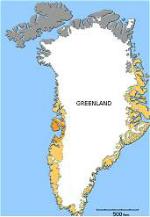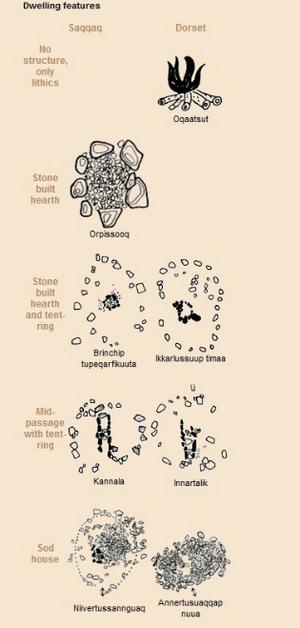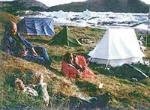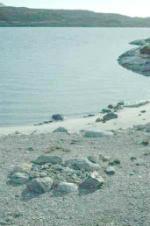
Early Dorset/Greenlandic Dorset
The Dorset culture is the latest of the pre-Inuit cultures in the eastern Arctic. Its earliest and latest datings are found in the Ungava Bay area, southern part of Hudson Bay. Dorset may be split into three periods:
Early Dorset 900 – 300 BC
Middle Dorset 300 BC – 500-600 AD
Late Dorset 400-500 – 1500 AD
In Greenland only the early phases and latest phases are represented in the dated material, approximately 700 BC - 200 AD and 1100 - 1300 AD. Recent studies of the Lithic technological traditions of the Greenland pre-Inuit cultures has confirmed that Independence II is identical to Early Dorset in Greenland thus designated "Greenlandic Dorset" (Grønnøw & Sørensen 2006).
Early Dorset geographical area

In Greenland Early Dorset artifacts have been found along the west coast from Inglefield Land in the far north and almost to the southernmost tip of Greenland, Cape Farewell. Genuine Early Dorset sites occur in numbers in central West Greenland, where Disko Bay stands out as the area where most sites have been registered so far. In the surveyed parts of Sisimiut district and in the large fiords around the capital Nuuk a fair number of sites are known as well. In Southwest Greenland Early Dorset is virtually unknown but single finds in Thule culture sites, and a site from Narsaq municipality do indicate that it must have existed here too. In East Greenland Early Dorset sites are known from the area around Dove Bugt in the north, from the Scoresby Sund area, around Ammassalik and from the district of Skjoldungen in Southeast Greenland.
Between these recently surveyed areas a few stray-finds indicate, that the Early Dorset groups also lived in entire East Greenland. By delineating the Early Dorset distribution to the above regions, we exclude the northernmost regions of Greenland, which is the traditional area of the largely contemporaneous Independence II culture. The separation of the two groups is difficult, but minor differences in the lithic artifact designs can be seen, probably as a reflection of the variations in resource base, which is conditioned by the extreme climatic settings in northernmost Greenland.
Social organisation of the Early Dorset

Very generally speaking, the excavated Early Dorset settlements of southern Disko Bay appear to fall into three categories or site types. Sites rich in finds characterised by 3-4 m x 4-5 m sub-rectangular dwelling structures with lowered floor areas. These sites often have well developed cultural layers covered or imbedded in thick peat deposits.
Sites with few artifacts (often no more than 10 tools), well defined dwelling structures in the form of circular or ovate tent-rings often with mid-passages. These sites are often located on gravel terraces with only little vegetation cover and with no cultural layers. Sites with artefact and debitage scatters and hearths but with no evident dwelling structure
Dwelling features

The preliminary interpretation of the three site categories is as follows:
– Sites rich in finds and with semi-subterranean dwellings are cold season dwellings used continuously over a long period of time and/or used over several years of periodical return.
– The mid-passage dwellings and tent-rings of boulders are characterised by their sparse artifact material. Presumably they are warm season dwellings and their restricted size often covering no more than 15 m2 suggests that they were used by single families only.
– The sites characterised by artifact scatters without dwellings may be hunting stations or other kinds of special purpose camps.
– The dwelling structures of the Early Dorset in Disko Bay thus gives an impression of relatively small groups of people who, during winter, probably lived in groups of a few families in one or several sub-rectangular winter dwellings with lowered floors. In summer people were mobile continuously on the move with portable dwellings in the form of tents. If people had lived two families together during winter, they probably lived separately in single family tents during summer. The mobile lifestyle allowed families to travel more freely even though the presence of several tent-rings on some sites indicate that travelling parties probably often were made up by two or three families.
– When comparing the Early Dorset situation from Disko Bay to the registered dwelling styles of Late Dorset in the far north of Greenland and Canada, the Early Dorset settlement patterns and dwelling styles clearly have more in common with the preceding Saqqaq culture, than it has with the Late Dorset. Good candidates for large congregation sites, so characteristic for the Late Dorset, are not found during the early pre-Inuit periods. This indicates that the Early Dorset people were living in smaller and more mobile groups than the Late Dorset people.
Natural resources of the Early Dorset

Settlement patterns and zoo-archaeological evidence indicate that Early Dorset utilised most available resources in their environment. In Disko Bay harp seal and ringed seal constituted the main game species, but birds, walrus, caribou, and polar bear were occasionally hunted as well. Unfortunately, only a few sites have sufficient zoo-archaeological evidence to allow for a more detailed study of the Early Dorset economy. The living resources provided food, and bone, ivory, antler as well as fur and hide for clothes. Lamps and other objects where carved in soapstone and a variety of lithics were utilised to manufacture bifacial blades, scrapers and microblades.
Quartz crystal, used mainly for production of microblades, can be acquired locally whereas agate and chalcedony, often dominating the Early Dorset lithic inventory, must be obtained on the Nuussuaq peninsula or on Disko island. "Killiaq", a silicate slate, is another raw material commonly used for the production of blades and burin-like tools. An outcrop of what appears to be a low grade killiaq is found on the island Angissat, whereas the high grade killiaq particularly used for the production of burin-like tools is available on the Nuussuaq peninsula and probably also on the island of Disko.
Subsistence pre-Inuit and Early Dorset raw material

Killiaq (a silicate slate) and agate (or chalcedony) are the two dominant raw materials in the lithic industries of central West Greenland. The natural occurrences of these raw materials are restricted to the cretaceous provinces of northern Disko Bay. Thus for tool making the pre-Inuit were highly dependent on exotic raw materials. Hitherto, raw material extraction has been documented only at two sites: 1) In the vicinity of the settlement Qaarsut on the northern shore of the Nuussuaq peninsula. 2) On the island Angissat in the southern part of Disko Bay.
Thin sections of prehistorically worked as well as recently collected killiaq indicate distinct crystalline differences among the two localities. The killiaq from Qaarsut appears to be of a better quality than the one from Angissat. Preliminary analysis of the occurrence of killiaq from Angissat in lithic inventories from pre-Inuit sites indicates that this raw material was used locally mainly in the southern part of Disko Bay, whereas the better killiaq qualities from Nuussuaq were distributed widely over central West Greenland. The most common raw material on Dorset sites is a very fine-grained chalcedony or agate, which also has its natural distribution in the Cretaceous provinces of Disko Bay. As with the killiaq, we also have evidence for wide-ranging distribution of this raw material along the coast of West Greenland.
Exchange and trade of the Early Dorset pre-Inuit and Early Dorset raw material exchange
Thin sections of prehistorically worked as well as recently collected killiaq indicate distinct crystalline differences on the killiaq from the two localities. The killiaq from Qaarsut appears to be more durable than the one from Angissat since the latter often develop a thick and distinct yellow patina, which never or only rarely are seen on burins and burin-like tools. Preliminary analysis of the occurrence of killiaq from Angissat in lithic inventories from pre-Inuit sites indicates that this raw material was used mainly locally, whereas the better quality killiaq from Nussuaq was distributed widely over central West Greenland.
Early Dorset history of research
There are plenty of Early Dorset artifacts in ethnographic and archaeologic collections from Greenland (Solberg 1907). However, knowledge of the Early Dorset have remained sporadic as only little systematic research or continuous effort has been done to enlighten the whereabouts of the Early Dorset. In Disko Bay scholarly excavations were carried out at the multi-component site of Sermermiut by Thomas Thomsen and Morten Porsild already at the beginning of the 20th century, but unfortunately both failed to describe the stratigraphy in such details, that the chronological sequence could be separated. This was not done until 1953 when Disko Bay once again was the focus of archaeological reconnaissance and excavation (Larsen and Meldgaard 1958).
During the 1953 fieldwork at Sermermiut, the chronological sequences of Saqqaq, Early Dorset and Thule were, for the first time, documented in a stratified context. Stratigraphical observations combined with C14 datings at the middens of Sermermiut (Larsen and Meldgaard 1958) and Qajaa (Meldgaard 1983) have placed the Early Dorset as a horizon from 600 BC to 200 AD, although this picture may be changed by new datings from other areas. Disko Fjord and coastal zones in northern Disko Bay were surveyed in 1977 and 1981 (Møbjerg 1986). These investigations generally confirmed the existing picture of the Early Dorset sites as being fewer in numbers than the Saqqaq sites.
Following the establishment of Greenlandic Home Rule in 1979 and a renewed interest among Greenlanders of their cultural heritage, many municipalities established local museums in the early 1980s. During the passed 18-20 years these institutions have often co-operated with the National Museum of Greenland and Danish institutions have initiated a large number of archaeological reconnoitring and excavations.
In 1982 the museums of Ilulissat and Qasigiannguit thus participated in the excavations at Qajaa (Meldgaard 1991), and in the following years the southern part of Disko Bay was surveyed on the initiative of the museum in Qasigiannguit (Grønnow 1994). In 1983 these surveys led to the discovery and subsequent excavation of the large Saqqaq site at Qeqertasussuk. When the excavations on Qeqertasussuk were finished in the late 1980s, the museums of Qasigiannguit and Aasiaat continued the archaeological activities by excavating Early Dorset sites in the southwest part of Disko Bay (Jensen 1994; Johansen and Stapert 1995, 1996; Rasch and Jensen 1997).
From 1995-1996 the museums of Qasigiannguit and Aasiaat, in co-operation with University of Copenhagen and University of Tromsø, Norway, carried out surveys and excavations of Palaeo-Eskimo dwelling structures and sites. During the 1995 fieldwork, 48 new stoneage sites were discovered in the research area, and subsequently five Saqqaq sites, three Early Dorset sites, two multi-component Saqqaq-Dorset sites and one Thule dwelling were excavated. The material from these excavations is published in Jens Fog Jensen: Stone Age of Qeqertarsuup Tunua (Disko Bugt), 2006.
